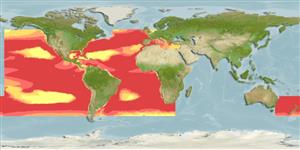Environment: milieu / climate zone / depth range / distribution range
Ökologie
seewasser bathypelagisch. Deep-water; 55°N - 49°S, 180°W - 180°E
Probably worldwide in tropical and subtropical seas. Eastern Atlantic: southern Ireland, scattered records in western Mediterranean, also Madeira Islands. Western Atlantic: Gulf of Mexico (Ref. 27768). Western Pacific: Australia (Ref. 7300) and New Zealand (Ref. 5755).
Size / Gewicht / Alter
Maturity: Lm ? range ? - ? cm
Max length : 21.0 cm TL Männchen/unbestimmt; (Ref. 3978)
Rückenflossenstacheln (insgesamt): 0; Rückenflossenweichstrahlen (insgesamt): 10-12; Afterflossenstacheln 0; Afterflossenweichstrahlen: 7 - 9; Wirbelzahl: 44 - 45. Body silvery, darker near tail (Ref. 3978). Swim bladder faintly colored. Adults mostly silver (Ref. 37473).
Mesopelagic species (Ref. 3978, 58302). Generally solitary. Probably feeds on zooplankton. Spawns throughout the year in the Mediterranean, more in winter.
Life cycle and mating behavior
Geschlechtsreife | Fortpflanzung | Ablaichen | Eier | Fecundity | Larven
Cohen, D.M., 1984. Argentinidae (including Microstomatidae). p. 386-391. In P.J.P. Whitehead, M.-L. Bauchot, J.-C. Hureau, J. Nielsen and E. Tortonese (eds.) Fishes of the north-eastern Atlantic and the Mediterranean, Volume 1. Unesco, Paris. (Ref. 4773)
IUCN Rote Liste Status (Ref. 130435)
Bedrohung für Menschen
Harmless
Nutzung durch Menschen
Fischereien: nicht kommerziell
Mehr Information
NamenSynonymeMetabolismusRäuberÖkotoxikologieFortpflanzungGeschlechtsreifeAblaichenSpawning aggregationFecundityEierEientwicklung
ReferenzenAquakulturAquakultur ProfilZuchtlinienGenetikElectrophoresesVererbbarkeitKrankheitenVerarbeitungNutrientsMass conversion
PartnerBilderStamps, Coins Misc.LauteCiguateraGeschwindigkeitSchwimmstilKiemenoberflächeOtolithsGehirngrößeSehfähigkeit
Tools
Zusatzinformationen
Download XML
Internet Quellen
Estimates based on models
Preferred temperature (Ref.
123201): 8.8 - 19.6, mean 13.4 °C (based on 608 cells).
Phylogenetic diversity index (Ref.
82804): PD
50 = 1.0000 [Uniqueness, from 0.5 = low to 2.0 = high].
Bayesian length-weight: a=0.00389 (0.00180 - 0.00842), b=3.12 (2.94 - 3.30), in cm total length, based on all LWR estimates for this body shape (Ref.
93245).
Trophic level (Ref.
69278): 3.4 ±0.45 se; based on food items.
Fishing Vulnerability (Ref.
59153): Low vulnerability (11 of 100).
